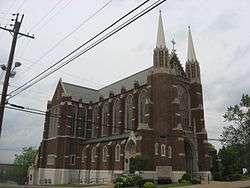Frank Seiberling

Frank Augustus Seiberling (October 6, 1859 – August 11, 1955) was an American inventor and founder. He is most famous for co-founding the Goodyear Tire & Rubber Company in 1898 and the Seiberling Rubber Company in 1921. He also built Stan Hywet Hall, a Tudor Revival mansion, now a National Historic Landmark and historic house museum in Akron, Ohio.
Biography
Career
Son of a German American entrepreneur from Ohio,[1] Seiberling spent two years attending Heidelberg College in Tiffin, Ohio, before joining the J.F. Seiberling Company, his father’s farm machinery manufacturing business, working there as secretary and treasurer.[2] His father, John Seiberling, founder of that Akron, Ohio company, invented one of the first reaping machines. While working for the company, Seiberling invented a twine binder that tied grain bundles with a bow knot.[3]
Many businesses failed in the panics of the 1890s, including the street railway company owned by Seiberling's father. In 1898, Seiberling was jobless, nearing forty years old, with a wife and three children. He learned of the availability of an old strawboard factory in East Akron, which he purchased, together with the 7 acres (28,000 m2) it stood on, for $13,500.[4] He borrowed $3,500 for a down payment from a brother-in-law, Lucius C. Miles.[5] In a few days he had decided what business he would go into, picked a name, and was selling stock. The business would be rubber; the company would be named for Charles Goodyear, the discoverer of vulcanization, who had died penniless almost forty years before.[4]
While Seiberling and his brother Charles were the co-founders of the Goodyear Tire & Rubber Company, its first president was David E. Hill, a business associate who purchased $30,000 of the company's initial stock. In 1899, Raymond C. Penfield, another brother-in-law, became the second president of the company; Lucius C. Miles followed in the position in 1900. In 1906, Frank Seiberling, until then the secretary and general manager, became the fourth president of the company, a position he held until 1921. He was known as the "little Napoleon" of the rubber industry because of his small stature and his unremitting determination to succeed. He played a leading role in developing Akron from a small town into the "rubber capital of the world."[4]
In 1921, Goodyear was refinanced and reorganized, and Frank and Charles Seiberling resigned from the company. Frank Seiberling then began the Seiberling Rubber Company in Barberton, Ohio. During his lifetime, Seiberling became famous for his fair treatment of workers.[2] In 1985, he was inducted into the Tire Industry Hall of Fame as a member of its inaugural class.
Philanthropy

In June 1911, Seiberling announced that he was financing an attempt at a transatlantic airship flight, to be headed by Melvin Vaniman.[3] In July 1912, the airship Akron exploded, and Vaniman and his crew were killed.[7]
Seiberling donated millions of dollars to charitable causes in his community. Akron's F.A. Seiberling Nature Realm has been named after him, the land that the park sits on was former Stan Hywet Hall and Gardens property; the family's former historic home which once spanned 15,000 acres now exists as much of the Akron-Fairlawn area. He donated much of Stan Hywet's acreage to the city of Akron, leaving the estate sitting on roughly 70 acres. The family's one time home now exists as a National landmark, and the biggest tourist attraction in the Akron area. He served on the board of trustees of Buchtel College and assisted the college in becoming the University of Akron.[2] Heidelberg University's Frank A. Seiberling Gymnasium is named in his honor, he was a very charitable donor to his alma mater.
Personal life
Seiberling was born on October 6, 1859, in Western Star, Ohio, a community a few miles southwest of Akron, in Summit County, Ohio. In 1887, he married Gertrude Ferguson Penfield (1866–1946). He died in Akron on August 11, 1955, and was buried in Glendale Cemetery.[8]
His grandson, John F. Seiberling, Jr., was a U.S. congressman from Ohio.
Further reading
- French, Michael. "Structure, Personality, and Business Strategy in the U.S. Tire Industry: The Seiberling Rubber Company, 1922–1964." Business History Review. 67:3 (Summer 1993).
References
- ↑ "Norton Area History". Retrieved 2011-03-02.
- 1 2 3 "Ohio History Central: Frank Seiberling". Retrieved 2008-10-06.
- 1 2 "To Back Cross-Sea Flight; Frank A. Seiberling Is Financing Mr. Vaniman's New Airship Project". New York Times. June 12, 1911.
- 1 2 3 "Frank A. Seiberling (1859–1955)". Retrieved 2008-10-06.
- ↑ "Goodyear: History Overview". Retrieved 2008-10-06.
- ↑ History, Holy Trinity Lutheran Church, 2012. Accessed 2013-05-19.
- ↑ "News Stuns Seiberling: Financial Backer of Vaniman Enterprise Made Balloon at His Factory". New York Times. July 3, 1912.. Akron was partly salvaged in 1982 (Akron expedition on the National Underwater and Marine Agency website)
- ↑ Vigil, Vicki Blum (2007). Cemeteries of Northeast Ohio: Stones, Symbols & Stories. Cleveland, OH: Gray & Company, Publishers. ISBN 978-1-59851-025-6